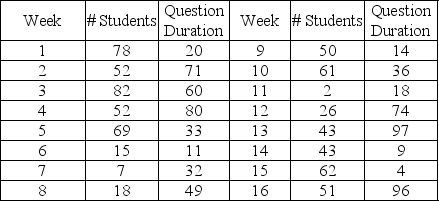Multiple Choice
Table 13-7
A professor dutifully holds six office hours per week as dictated by an archaic policy.Demand for office hours varies wildly as reflected in this historical data.
 The duration of time to answer questions varies independently from the actual demand.Question duration is reflected in this table.
The duration of time to answer questions varies independently from the actual demand.Question duration is reflected in this table.
 Entries in the student demand and question duration tables that reflect a range in demand, i.e., 3-9 students per six hours or 4-9 minutes should be treated as collapsed entries in the table.Thus, a question duration of 4 minutes has a 0.05 probability, a question duration of 5 minutes also has a 0.05 probability, and so on up through 9 minutes and a 0.05 probability.
Entries in the student demand and question duration tables that reflect a range in demand, i.e., 3-9 students per six hours or 4-9 minutes should be treated as collapsed entries in the table.Thus, a question duration of 4 minutes has a 0.05 probability, a question duration of 5 minutes also has a 0.05 probability, and so on up through 9 minutes and a 0.05 probability.
This table contains random numbers for the number of students and duration of question for a 16-week period.
 Use the question duration figure as the time required to answer questions for each student that week, so if three students arrive in week seven and the average duration is ten minutes, the total time spent answering questions that week is thirty minutes.
Use the question duration figure as the time required to answer questions for each student that week, so if three students arrive in week seven and the average duration is ten minutes, the total time spent answering questions that week is thirty minutes.
-Use the information in Table 13-7 to determine the range of random numbers that corresponds to 10 students showing up for office hours.
A) 21 to 25
B) 20 to 24
C) 20 to 25
D) 21 to 24
Correct Answer:

Verified
Correct Answer:
Verified
Q4: Table 13-4<br>A pawn shop in Arlington, Texas,
Q5: The Monte Carlo simulation is used with
Q6: Simulation models may contain both deterministic and
Q7: When establishing a probability distribution based on
Q8: Which of the following is not an
Q10: The advantage of simulation over queuing or
Q11: There are three categories of simulation models:
Q12: A major advantage of using simulation techniques
Q13: The Monte Carlo simulation was developed by<br>A)John
Q14: The demand for refrigerators at an appliance